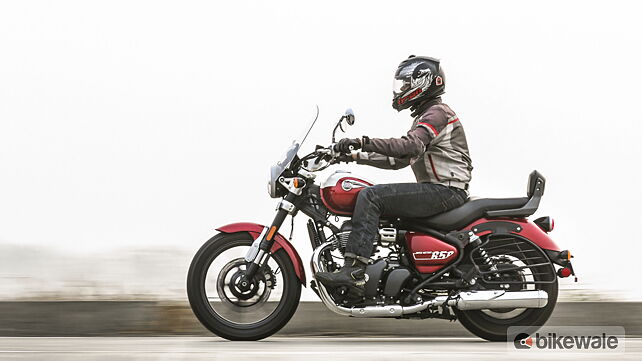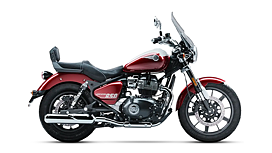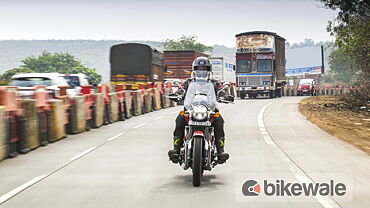Introduction

Why to buy it?
- Powerful yet tractable engine
- Comfortable riding posture
- Nimble handling
Why to avoid it?
- Stiff ride quality
- Difficult to put on the main stand
This is Royal Enfield’s newest and most premium offering, the Super Meteor 650. It represents the brand’s take on a middle-weight, multi-cylinder cruiser which Vikrant recently rode on the divine roads of Rajasthan. While he came back fairly impressed with the bike, there’s no getting around the fact that Rajasthan (Jaisalmer, in particular) has some of India’s smoothest and least crowded roads, thereby not being the ideal testing ground for a bike that’ll be sold in all parts of India.

In that case, we got the bike in Mumbai for a comprehensive road test and to answer every question that you all have been asking us about its everyday usability. Is the low ground clearance an issue? How comfortable is the suspension setup? Is the engine exactly the same as the Interceptor 650? Does the heavy kerb weight … the list goes on! So, without any further ado, let’s see if the Super Meteor 650 can be the only motorcycle in your garage.
Styling and Quality

The adjectives I choose to describe the Super Meteor’s design are imposing, proportionate, and opulent. It boasts a long wheelbase in a typical cruiser fashion but doesn’t look overly outstretched. In fact, it’s a great amalgamation of retro elements, like a round headlamp and teardrop-shaped fuel tank, with a dash of modernity coming from blacked-out alloy wheels and engine casing. However, its colour palette should’ve had at least one trim with oodles of chrome, like Mr Clean of Continental GT 650, which is absent as of now.

In terms of quality and fit and finish, it is difficult to find faults with the Super Meteor. The attention to detail, the fitment of panels, and the quality of metal, plastic, and paint — all ooze with that premium feel. Certain elements like the switch cubes with brushed aluminium finish, the 3D Royal Enfield logo on the fuel tank, and the Monza-style fuel filler cap make it look like a much more expensive bike than it actually is. The only niggle I find is with the quality of the touring windscreen. Every time I get stuck in stop-and-go traffic at night and need to see through the glass, the image of what’s ahead of the front wheel is distorted. So, I always have to lean on one side to get a clear view of the front.
Ergonomics and Comfort

Getting astride the 740mm high seat of the Super Meteor shouldn’t be an issue even for the shorter riders. Once aboard, you’ll appreciate the roomy seat and easily reachable and wide handlebar of the bike. However, if you have the habit of riding a street or a sport bike with more neutral ergonomics, placing your feet on such forward-set pegs might feel awkward initially. But once you get a hang of it, the laid-back ergonomics of the bike give an impression of seating on a comfy couch. While the riding triangle is supremely comfortable for the highway, the feet-up-feet-down action in slow-moving traffic doesn’t feel unnatural either. Do note that our test bike is the Celestial variant with a seat and handlebar different from the Astral and Interstellar’s stock setup. The latter two get a narrower handlebar and a slimmer and shorter seat.

Although the ergonomics of the Super Meteor on the slick highway are commendable, things aren’t that rosy when the road surface gets bad. The suspension of the bike, especially the rear, is tuned to be stiff. So, if you don’t slow down through imperfections like potholes, rumblers, or protruding manhole covers, you’re treated with a nasty jolt to the back. Even while cruising on the highway at higher speeds, when you encounter sections with low-amplitude dips and crests, you get a continuous bobbing sensation at the rear, which otherwise feels planted when riding through plain sections. On the brighter side, the ride feels marginally plusher if you add some weight in the form of a pillion or stuffed panniers.

Now, one reason for the suspension being firm is to mitigate the hindrances which come with a low ground clearance of 135mm. A softer setup would’ve allowed more movement of the suspension, thereby making the underside more prone to scraping. Surprisingly, while riding solo, and no matter what the speed, I’ve never had any of the bike’s low-hanging parts touching the tall speed bumps. However, when my colleague Ajinkya, who is almost as heavy as me at 82kg, joined me as a pillion, the lower side of the exhaust shield scraped a tall speed breaker. So, you have to be more careful while riding with a passenger, with heavy luggage, or both.
Performance and Handling

This is the area where the Super Meteor 650 shines bright. Barring the different intake ports and exhaust, the 648cc, parallel-twin, air/oil-cooled engine is the same as the Interceptor 650 and Continental GT 650. This is an extremely versatile engine which is a treat to operate in the city as well as on the highway. You can potter around in the third or fourth gear at speeds of around 30kmph and accelerate ahead briskly without downshifting. Oodles of torque available almost across the rev band negates the need to constantly downshift while also delivering a punchy acceleration most of the time.

It’s the same story on the highway. Even at speeds as high as 120kmph, the Super Meteor feels unstrained and free of any major vibrations. Overtaking on the highway feels like a cakewalk for the bike and you don’t need to do much planning or downshifting. Helping its case further is the slick six-speed gearbox which shifts with a soft clunk yet minimal effort. Except for a few times in traffic, I never came across false neutrals or missing shifts. And you experience all this while enjoying the sweet rumbling acoustic emanating from the exhaust. Now, while the Super Meteor 650 is fast and peppy, it takes noticeably more time to build up pace than its older 650cc siblings, mainly due to the substantially heavier kerb weight.

Talking about the weight, the Super Meteor tips the scales at 241kg (kerb), which is pretty heavy. To give you a perspective, the Interceptor 650 and Continental GT 650 weigh 213kg and 211kg, respectively. Hence, the Super Meteor feels a little cumbersome at times, such as when putting it on the main stand, pushing it out of a parking space, or trudging along in crawling traffic. However, once you get in motion, all the weight disappears and the bike feels surprisingly nimble for its weight. Although you need to put in some effort on the handlebar to change direction, it never demands to be muscled laboriously. Not to mention, it’s particularly mind-blowing around corners in ghats where tipping the bike in and holding the desired line feels natural and quick. It inspires so much confidence that you start grinding the pegs in no time.

Adding to the confidence are the brakes of the Super Meteor which are hands down the best anchors I’ve experienced on a Royal Enfield so far. The ByBre front calipers bring this 241kg behemoth to a halt at the drop of a hat. There’s a tremendous yet progressively arriving bite, coming in without much effort on the lever. The rear brake, meanwhile, feels more progressive yet delivers an adequate amount of bite.
Features and Technology

On the feature front, the Super Meteor justifies its premium positioning with bits like a full-LED headlamp, semi-digital console, Tripper navigation as standard, a slipper clutch, adjustable brake and clutch levers, and a USB charger. However, the USB charger is placed behind the left-side under-seat cover which makes you open it every time you want to charge your phone. This will be a hassle for those who’ll use it often. Also, the instrument cluster looks identical to the one available in the Meteor 350 which takes away the sense of exclusivity to some extent.

Fuel Efficiency
In case you’re wondering ‘Kitna deti hai?’ In BikeWale’s real-world mileage test, which involved low to moderate traffic along with some open roads, the Super Meteor 650 returned a fuel efficiency of 23.7kmpl. That’s not bad at all, considering you get a range of about 372km with its 15.7-litre fuel tank filled to the brim.

Should you buy it?

If you’re out in the market for a middle-weight, multi-cylinder cruiser, the Super Meteor 650 is a tremendous value with its prices starting from Rs 3.5 lakh (ex-showroom). You see, the positioning of the motorcycle makes it a no-brainer. Today, if you want an entry-level cruiser, you can either opt for the Bajaj Avenger 220, which is quite dated now, or the Meteor 350. However, if you want a mid-size cruiser with attractive pricing, the Super Meteor 650 is the most enticing option because its closest rivals, the Benelli 502C and the Kawasaki Vulcan S are substantially more expensive.

Now, buying it means there are certain limitations you have to live with, which are typical of a cruiser. The ride quality is pretty stiff when you’re riding solo. However, it feels slightly more settled if you add the weight of a pillion or luggage. But doing that means you have to be cautious about the low ground clearance. As for the heavy kerb weight, I believe getting used to that aspect won’t take much time.

Having said that, the Super Meteor is profoundly enticing in terms of engine performance, refinement, handling, braking hardware, comfort, and build quality. For a modern classic, it’s also decently loaded with contemporary features. So, if you’re hell-bent on buying a cruiser under Rs 4.5 lakh (on-road) which can munch miles on the highway while being your daily driver, the Super Meteor is a fantastic option.
Photography by Kaustubh Gandhi
Gallery
1/125
Royal Enfield Super Meteor 650 Left Side View
Double Tap to Zoom













































![KTM 390 Adventure X [2025] KTM 390 Adventure X [2025]](https://imgd.aeplcdn.com/272x153/n/cw/ec/190885/390-adventure-x-2025-right-side-view.jpeg?isig=0&q=80)